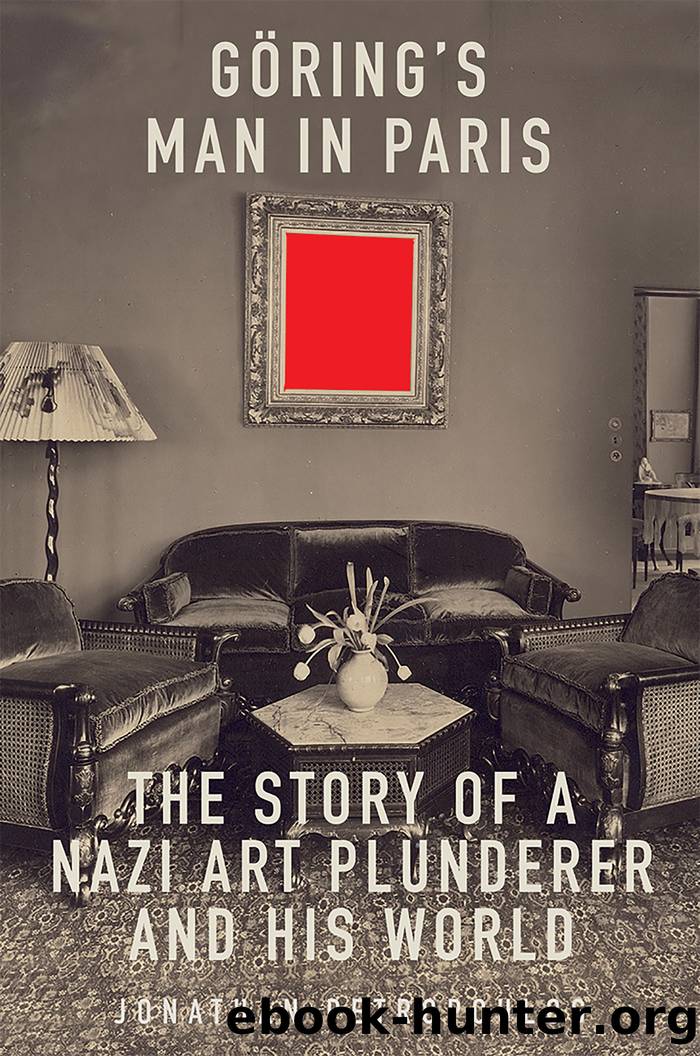Goering's Man in Paris by Jonathan Petropoulos

Author:Jonathan Petropoulos
Language: eng
Format: epub
Publisher: Yale University Press
Published: 2020-02-14T16:00:00+00:00
CHAPTER EIGHT
Restitution
CAMILLE PISSARRO PAINTED Le Quai Malaquais et lâInstitut (known as the âFischer Pissarroâ) as the final work in a series of now iconic cityscapes of Paris.1 In 1903, the artist was living on the third floor of the Hôtel du Quai Voltaire on the Left Bank of the Seine, with a view of the dome of the Institut de France and the Pont-Royal, among other notable landmarks. He painted the picture looking out the window of the room in which he died a short time later. Pissarro, a Jewish artist, painted the picture in the midst of the âDreyfus Affair,â a scandal about a spy among the French General Staff that riveted the nation and gave rise to acute anti-Semitism. Captain Alfred Dreyfus was an Alsatian Jew who was falsely accused of spying for the Germans. Pissarro himself believed that he (Pissarro) looked stereotypically Jewish, with a pronounced nose, and he feared for his life on the streets of Paris. He therefore opted to paint from the safer spaces provided by the upper floors of various Paris buildings, including the Grand Hôtel du Louvre, which looked out on rue Saint Honoré, and the apartment he rented overlooking the Seine. Despite the trying circumstances, the French capital had afforded him the opportunity to work and flourish, and it served as an aesthetically rich subject of his art. Art dealer Walter Feilchenfeldt noted, âInspired by the emerging spring season in April and May, these works are filled with a sense of hope, of renewal, of new leaves and new life.â2 But there is also a sadness, a pathos to these cityscapes. Le Quai Malaquais is a reflection of the polarized, anti-Semitic atmosphere of the times, and as one the last pictures that Pissarro created, it is a poignant work on many levels.
The Fischer Pissarro is also in many respects a Jewish picture. After the artistâs death his son, Paul Ãmile Pissarro, who was also a painter, inherited it. To say that the younger Pissarro was not as successful as his father would be an understatement, and Paul Ãmile turned to family friends, the Cassirers, to sell the work. The Cassirers constituted one of the great cultural families of Germany, with a famous publisher (Bruno), art dealer (Paul), and philosopher (Ernst) among their ranks. They were prominent, assimilated Jews, a kind of role model for those who believed in a progressive Germany. In 1907, Paul Cassirer sold the painting to Samuel Fischer, head of the eponymous publishing house Fischer Verlag, which published Sigmund Freud and Thomas Mann, among other prominent authors. Samuel Fischer was also Jewish and a visible member of the European intellectual elite. The painting remained in the possession of the Fischer family from one generation to the next, continuing on to daughter Brigitte (âTuttiâ) and her husband, Gottfried Bermann Fischer, who took over the publishing house when Samuel Fischer died in 1934. Paintings become associated with owners, especially when they are passed down across generations. They assume additional emotional significance because family members live in close proximity to the works.
Download
This site does not store any files on its server. We only index and link to content provided by other sites. Please contact the content providers to delete copyright contents if any and email us, we'll remove relevant links or contents immediately.
Blood and Oil by Bradley Hope(1511)
Wandering in Strange Lands by Morgan Jerkins(1359)
Ambition and Desire: The Dangerous Life of Josephine Bonaparte by Kate Williams(1329)
Daniel Holmes: A Memoir From Malta's Prison: From a cage, on a rock, in a puddle... by Daniel Holmes(1282)
It Was All a Lie by Stuart Stevens;(1243)
Twelve Caesars by Mary Beard(1231)
The First Conspiracy by Brad Meltzer & Josh Mensch(1124)
What Really Happened: The Death of Hitler by Robert J. Hutchinson(1113)
London in the Twentieth Century by Jerry White(1097)
Time of the Magicians by Wolfram Eilenberger(1074)
Twilight of the Gods by Ian W. Toll(1071)
The Japanese by Christopher Harding(1067)
Cleopatra by Alberto Angela(1044)
A Woman by Sibilla Aleramo(1041)
Lenin: A Biography by Robert Service(1027)
The Devil You Know by Charles M. Blow(972)
Reading for Life by Philip Davis(956)
1965--The Most Revolutionary Year in Music by Andrew Grant Jackson(909)
The Life of William Faulkner by Carl Rollyson(902)
